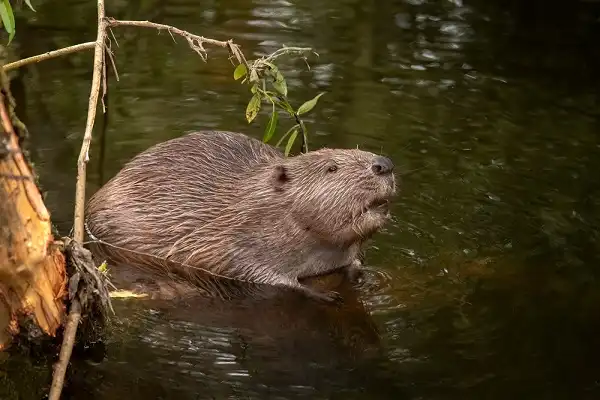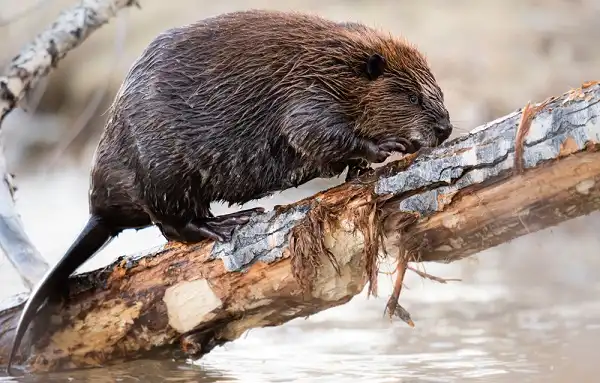Beavers are North America’s largest rodents and can weigh up to 60 pounds. They are plant-eating animals that build dams and lodges out of woody vegetation. Beavers play an important role in their ecosystems by modulating water flow and providing homes for other animals. Although they are shy animals, beavers can become aggressive when provoked. This post will explore the habits and history of these interesting creatures.

Beaver Description
Beavers are large, semi-aquatic rodents that have been found in North America for millions of years. They have thick fur, webbed feet, and a flat tail that helps them swim. When building their dams and lodges, beavers use all types of woody vegetation such as twigs, branches, bark, leaves, and logs. Beavers are highly social creatures who live in family units consisting of a breeding pair and their offspring. They typically inhabit wetlands but can survive in other habitats due to their remarkable ability to manipulate the environment.
Beaver Habitat
Beavers are found throughout much of North America, including Alaska, Canada, and the United States. They prefer habitats with a combination of water and land, such as wooded wetlands, riverbanks, and ponds. Beavers require access to a food source such as trees or shrubs for browsing on the leaves, bark, and twigs. Access to water is also essential for the beaver’s lifestyle which includes swimming and building dams. In addition to wetland areas, beavers inhabit marine shorelines where they use their dens as shelter from predators while they feed on saltwater plants in nearby estuaries. Beavers may even occasionally venture away from water sources when searching for food during winter months or when new areas need to be colonized. They are well adapted for digging burrows into banks or making tunnels through snowdrifts in search of food sources beneath the surface. Beavers play an important role in balancing ecosystems across North America due to their ability to construct dams and modify waterways. By maintaining regular water levels within their habitats, these animals help maintain healthy riparian environments which are important for many species’ survival. Beavers also help reduce erosion by forming ponds and creating wetlands as well as providing housing for other animals such as muskrats and frogs who may benefit from living near these industrious creatures!
Beaver Diet
Beavers are primarily herbivores, and their diet consists of a variety of plants such as aquatic vegetation, grasses, sedges, ferns, and even occasionally fish or birds. Beavers are clever builders and they store food for winter by collecting branches and piling them near their lodge or dam. Beavers have adapted to become quite efficient eaters as they have the ability to use their sharp front incisors to strip bark from trees. They also have an upper lip that is split in two so that they can grab and pull twigs, leaves, and other plant matter. As well as eating bark, beavers will also feed on the leaves of trees such as birch and willow which they can easily break off with their claws. In addition to tree bark and leaves, beavers also consume aquatic plants such as water lilies or eelgrass which provides them with essential vitamins and minerals during the summer months. During winter months when food is scarce, beavers may venture away from the water’s edge in search of food sources beneath the snowdrifts or burrows dug into banks.

Beaver Size
Beavers can range in size from 2-3 feet long, with a tail of 6-10 inches, and weigh anywhere between 11-33 pounds. Their physical characteristics vary greatly depending on their location and the particular species or subspecies – for instance, North American beavers are generally larger than those from Europe or Asia. Beavers have short ears, small eyes, and a wide snout that can open up almost 75 degrees when feeding. They also possess incisor teeth which grow continuously throughout their lives as they chew through woody vegetation; this is why it’s important for a beaver’s diet to contain sufficient amounts of calcium in order to maintain healthy teeth growth. Beavers also have specially adapted lips that work like fingers allowing them to pick up twigs, leaves, and other plant matter with ease.
Beaver Lifespan
Beavers typically live between 7-10 years in the wild but can reach up to 20 years in captivity. In general, male beavers tend to live longer than females due to their larger size and higher energy stores. Beavers also have a high level of intelligence which helps them increase their chances of surviving harsh winters and avoiding predators. Beavers usually begin reproducing at two or three years old, with mature individuals breeding once a year during the spring. Females give birth to litters of 1-7 kits after a gestation period of approximately 90 days. Most kits leave the family lodge by their second year and may even disperse from home ranges as far as 50 miles away! The average lifespan for beavers is significantly affected by environmental factors such as predation, disease, food availability, habitat quality, and human interference; however, it is also heavily influenced by an individual’s age, genetics, and lifestyle.
For instance, beavers that are well-fed, have access to sufficient shelter, and are not constantly harassed by humans tend to live much longer than those who do not enjoy the same benefits. In order to remain healthy throughout their lifespans, beavers must maintain a balanced diet that includes bark, leaves, aquatic plants, and occasionally small prey items like fish or frogs when available. They must also continue building dams and lodges in order to provide safe shelters against cold temperatures or potential predators. Although they are capable swimmers and can stay underwater for up to 15 minutes at a time while gathering food sources or constructing dams, they rely heavily on land-based resources such as woody vegetation in order to get through long winters without having to venture too far from home.
Beaver Behavior
Beavers are known to be very active animals and can often be seen swimming, gnawing on trees, and building dams at any time of day. They communicate with one another by slapping their tails on the water and have a variety of vocalizations that they use to indicate distress or happiness. Beavers are highly social creatures and often live in large family groups with up to 10 individuals sharing the same lodge. Beavers also show territorial behavior, as they will mark their territory using their musk gland secretions that other beavers can recognize from a distance. Not only do they use these secretions for communication but also for defense against predators such as foxes or coyotes. Furthermore, beavers build dams and lodges in order to protect themselves from potential predators as well as provide them with an abundant food source that is close by throughout the year. Beaver behaviors such as slap tailing, vocalizing, scent marking, and territorial activities are all signs of dominance within a colony; however younger generations of beavers demonstrate more subordinate behaviors such as deferring feeding rights during competition over resources. This is why it’s important for older members of the colony to maintain good relationships with younger ones in order to ensure the survival of any particular family unit over time.

Beaver Speed
Beavers are actually quite fast animals, capable of reaching speeds up to 5 mph both on land and in the water. They can accomplish this because of their specialized webbed feet, which help them gain purchase in the water. One of the reasons why beavers have such impressive speed is their long stride length; they use their back legs and tails as paddles that quickly propel them through the water at high speeds. Much like other rodents, beavers also have sharp claws that help them dig into soil and wood in order to build dams and lodges or scavenge for food sources. In addition to their natural speed, beavers also rely heavily on teamwork when it comes to outrunning enemies – younger members of a family unit will often follow closely behind an older one in order to ensure everyone’s safety. Furthermore, if they identify potential dangers early enough they will often dive into deeper areas of a lake or river where they can hide beneath submerged logs and rocks while keeping an eye out for any unwanted guests!
Beaver Hunting
Beavers are very popular targets for hunters looking to bag some impressive games. They are well-known for their thick fur, which is highly sought after by many hunters, and their impressive speed makes them even more challenging to catch. To hunt a beaver successfully, it is important for the hunter to have knowledge of the animal’s habits and habitat as well as have access to a good hunting dog or two. The best time of year to hunt beavers is generally at night when they are most active; this is also when they tend to move around more often in order to find food. When it comes to bait, hunters should use pungent-smelling meats such as fish guts or chicken livers since these will attract any nearby beavers quickly. Beavers also rely heavily on scent while navigating so lure sticks with strong odors can also prove effective when placed close enough to a potential nesting site. Once the bait has been set up successfully, it’s important for the hunter to remain still and quiet in order not to alarm any nearby animals.

Conclusion
Beavers are one of the most incredible animals that nature has blessed us with. Their impressive size and strength along with their intelligence and resilience make them a formidable species that have adapted to survive in many different habitats all over the world. As expert builders, swimmers, and hunters, beavers can easily construct dams and lodges in order to create safe havens for themselves or access aquatic vegetation for vital nutrients. They are also popular targets for hunters looking to bag some impressive game although caution should be taken when harvesting one of these animals due to their importance to local ecosystems. All in all, beavers are truly admirable creatures who deserve our respect!
Frequently Asked Question


